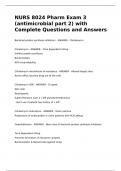Samenvatting
Samenvatting: Behavioral Interventions in Cognitive Behavior Therapy
- Vak
- Instelling
- Boek
Dit document omvat een samenvatting van hoofdstuk 1-4 en 8-9 van het boek Behavioral Interventions in Cognitive Behavior Therapy, deze hoofdstukken zijn verplicht voor het tentamen. Dit document kan als vervanging dienen voor het boek en is in het Engels geschreven.
[Meer zien]













